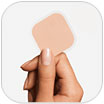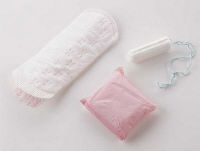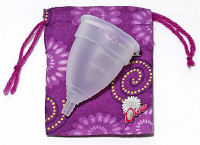Dealing With Your Period While Traveling: Taking Aunt Flo on the Road
Many of the women who embark on big journeys throughout the world are still of the age when they’ll have to deal with getting a period each month. Depending on how long you’ll be traveling, and where you’ll be going, you’ve got a couple of options as far as how to deal with your period when you’re traveling. This article will discuss those options in general terms, but please keep in mind that we are not doctors! You should always check with your personal physician before changing your birth control regimen or trying a new method of dealing with your period.
Learn more about all aspects of long-term trip planning by signing up for our free e-course, Plan Your RTW Trip in 30 Days!
That said, here are a few things you might want to talk to your doctor about.
Stopping Your Period Entirely
Some women choose to trick their bodies into not having a period every month – and this doesn’t mean getting pregnant, either! Most of the women who use this method will have periods about once every four months or so, and generally speaking these are things you’ll need to start before you leave on your trip. So it’s important that you schedule an appointment to talk with your doctor well in advance of your departure so you can figure out which one you want to do and have enough time to make sure it works for you before you’re off on the road.
Also remember that the side effects for each of these methods will vary – so be an educated consumer and do your research on them before you go see your doctor (one good resource is the Planned Parenthood birth control page here), and don’t be afraid to ask your doctor any questions you have. Just because something worked like a charm for your sister or best friend doesn’t mean it’ll work for you, so pay attention to your body and tell your doctor if you’re having any problems.
There are a few ways to skip your period when you’re traveling – the most common are listed below.
Birth Control Pills
 Women who use “the pill” to skip most of their periods used to just skip the week of sugar pills and go straight onto the next pill pack, which keeps the body thinking it’s pregnant. While this method still works, there are also new birth control pills on the market which are designed specifically to have a period once every four months or so. Ask your doctor about both the old pills and the new pills, and give yourself time to get used to a new prescription if you’re changing pills.
Women who use “the pill” to skip most of their periods used to just skip the week of sugar pills and go straight onto the next pill pack, which keeps the body thinking it’s pregnant. While this method still works, there are also new birth control pills on the market which are designed specifically to have a period once every four months or so. Ask your doctor about both the old pills and the new pills, and give yourself time to get used to a new prescription if you’re changing pills.
- Advantages for the traveler: Many women are already comfortable with the pill and know how their body reacts to it.
- Disadvantages for the traveler: Pills must be taken at the same time every day, and that once-quarterly period can be a real doozy.
The Patch
 Although the delivery method is completely different, the birth control patch functions in a similar way to the birth control pill. With the patch (which you may know by its most common brand name, Ortho Evra), you put an adhesive patch on your body which releases hormones into your bloodstream via your skin. It gets changed once a week, and the way you’d skip your period would be to just put on a new patch for the fourth week instead of giving your body a patch-free week.
Although the delivery method is completely different, the birth control patch functions in a similar way to the birth control pill. With the patch (which you may know by its most common brand name, Ortho Evra), you put an adhesive patch on your body which releases hormones into your bloodstream via your skin. It gets changed once a week, and the way you’d skip your period would be to just put on a new patch for the fourth week instead of giving your body a patch-free week.
- Advantages for the traveler: Only has to be remembered once a week, and can be worn while swimming, exercising, bathing, etc.
- Disadvantages for the traveler: Patches should be kept at room temperature, which may present problems for those traveling through warm climates, and the patch will also be noticeable if placed in an area that’s visible when wearing a tank top, swimsuit or other revealing piece of clothing.
Vaginal Rings
 Like birth control pills and birth control patches, vaginal rings also release hormones into your bloodstream – only this one is (as you may have guessed from the name) inserted into your vagina rather than swallowed or stuck to your skin. The most common brand name for the vaginal ring is the NuvaRing. Vaginal rings must be removed after three weeks, and they can be worn by exercising, swimming, and even during sex. Like with the patch, you’d skip your period with a vaginal ring by immediately inserting a new ring after the third week instead of going without for the fourth week.
Like birth control pills and birth control patches, vaginal rings also release hormones into your bloodstream – only this one is (as you may have guessed from the name) inserted into your vagina rather than swallowed or stuck to your skin. The most common brand name for the vaginal ring is the NuvaRing. Vaginal rings must be removed after three weeks, and they can be worn by exercising, swimming, and even during sex. Like with the patch, you’d skip your period with a vaginal ring by immediately inserting a new ring after the third week instead of going without for the fourth week.
- Advantages for the traveler: Only has to be remembered once a month, and uses less hormones than birth control pills.
- Disadvantages for the traveler: Although rare, the ring can fall out (if this occurs, it must be rinsed with sanitary water, which may be hard to find depending on where you are), and approximately 20% of men whose partners use a vaginal ring say they can feel the ring during intercourse.
Depo-Provera, AKA “The Shot”
 Many of you will be familiar with the name Depo-Provera, the most common birth control shot on the market. It’s progestin-only birth control, and it’s dispensed by a medical professional in the form of a shot you get every three months either in the arm or in the buttocks. If you’ll be traveling for longer than three months, you can talk with your doctor about getting a prescription to take with you in order to get a shot on the road – just be sure you’ll be somewhere they’ll honor that prescription when you need it.
Many of you will be familiar with the name Depo-Provera, the most common birth control shot on the market. It’s progestin-only birth control, and it’s dispensed by a medical professional in the form of a shot you get every three months either in the arm or in the buttocks. If you’ll be traveling for longer than three months, you can talk with your doctor about getting a prescription to take with you in order to get a shot on the road – just be sure you’ll be somewhere they’ll honor that prescription when you need it.
- Advantages for the traveler: No pill to remember to take every day, and can be used by women who cannot take estrogen.
- Disadvantages for the traveler: Your period is not guaranteed to stop, and treatment should be started well in advance of your trip to see how your body reacts the shot.
Continuing Your Period While Traveling
For most women, the question isn’t how to stop having your period, it’s how to deal with your period while you’re traveling – no matter where you’re going, or how long you’ll be gone. The good news is that tampons and pads can be found in any major city throughout the world. The bad news is that travelers don’t stick to major cities! So even if you’ve never thought about options besides tampons and pads, you may want to explore some alternatives for your trip.
Tampons & Pads
 As mentioned, both tampons and pads (also called sanitary napkins) are widely used throughout the Western world and beyond, and therefore readily available in most cities and towns. Tampons are generally made of cotton and rayon and are worn internally. Pads are generally made of cotton, rayon and plastic and are worn externally. The most common pads are disposable and fasten to your underwear with an adhesive strip, but older styles were held in place by a belt – and some women use cloth pads which are usually made of cotton or flannel and can be washed and reused.
As mentioned, both tampons and pads (also called sanitary napkins) are widely used throughout the Western world and beyond, and therefore readily available in most cities and towns. Tampons are generally made of cotton and rayon and are worn internally. Pads are generally made of cotton, rayon and plastic and are worn externally. The most common pads are disposable and fasten to your underwear with an adhesive strip, but older styles were held in place by a belt – and some women use cloth pads which are usually made of cotton or flannel and can be washed and reused.
- Advantages for the traveler: Most women are familiar and comfortable with tampons and pads, and they can be found in most major cities and towns throughout the world.
- Disadvantages for the traveler: You may not be able to find your favorite brands overseas (for example, it can sometimes be difficult to find tampons with applicators), and both tampons and pads can be expensive compared to the prices you are used to paying. If you decide to bring your own supplies, that will take up room in your backpack. Also keep in mind that in some areas you will not find good septic systems, so you won’t be able to flush your used tampons. You may be required to burn them, or carry them in a bag until you are able to dispose of them. (If you do need to carry used tampons or pads, keep them in a zipping plastic bag with some baking soda to reduce the odor.)
Cervical Cups
 Cervical cups are inserted into the vagina and, unlike pads or tampons, are non-absorbent. After removal, contents are dumped into the toilet and the cup is washed in hot, soapy water and re-inserted – which may be a challenge if you’re in a public restroom! In that situation, one cervical cup maker advises wiping the cup with a dry or damp clothing and cleaning it then next time you are able. Some of the brand names you may have heard of are Diva Cup and The Keeper.
Cervical cups are inserted into the vagina and, unlike pads or tampons, are non-absorbent. After removal, contents are dumped into the toilet and the cup is washed in hot, soapy water and re-inserted – which may be a challenge if you’re in a public restroom! In that situation, one cervical cup maker advises wiping the cup with a dry or damp clothing and cleaning it then next time you are able. Some of the brand names you may have heard of are Diva Cup and The Keeper.
- Advantages for the traveler: Makers claim there is no leakage with cervical cups, unlike pads and tampons. The cups can be worn overnight and are reusable, saving packing space.
- Disadvantages for the traveler: You might be unfamiliar with the product, and further you may be uncomfortable with the idea of inserting the plastic cup into your vagina yourself. Travelers may also not have access to a private bathroom for awhile and would need to rise the cup in public space – and if hot, clean water is not available, the cup could become unsanitary for use.
Sea Sponges
 These sponges, as the name implies, are natural sponges that grow on the ocean floor and are harvested for a number of uses. They’re highly absorbant, and the ones marketed for menstruation are worn internally (like tampons). One of the largest producers of sea sponge tampons is Jade and Pearl.
These sponges, as the name implies, are natural sponges that grow on the ocean floor and are harvested for a number of uses. They’re highly absorbant, and the ones marketed for menstruation are worn internally (like tampons). One of the largest producers of sea sponge tampons is Jade and Pearl.
- Advantages for the traveler: They are a natural alternative to tampons – TSS is not associated with sea sponges as it is with tampons. Sea sponge tampons can be used for 6-8 cycles.
- Disadvantages for the traveler: It can be difficult to figure out how to use sea sponges (they should be removed and rinsed out every three hours in a sink). While traveling, they may be difficult to keep sanitary.
Conclusions
Obviously, how you deal with your period while you’re traveling is both a highly personal decision and something you’ll probably want to discuss with your doctor. Unless you’re going to be doing the same exact thing you already do (and that your doctor already knows about), this may require a couple of visits and some time to get used to a new product – so whatever you do, don’t leave this to the last minute!
And for some discussions on this topic, with lots of real-life travel experiences, here are a few great threads on the BootsnAll boards: